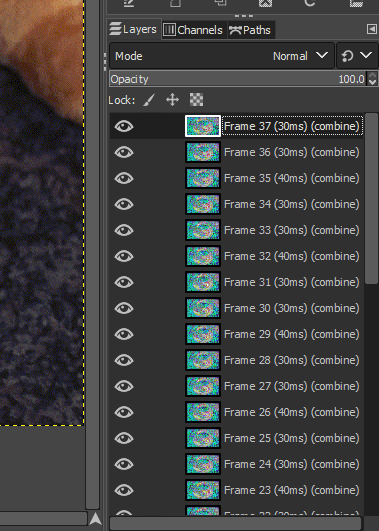

- #Gimp gap extract video frames how to
- #Gimp gap extract video frames pdf
- #Gimp gap extract video frames manual
- #Gimp gap extract video frames software
- #Gimp gap extract video frames download
The software does not bother you with the repairing process. Effective Video Repair Software to fix bad framesĪ simpler and quick way to fix bad frames in your videos is to use a specialized video repair software such as Stellar Repair for Video. It has worked for many users to fix the frame corruption problem in their videos. However, if you have the knowledge of the software, you can try out the below command line:įfmpeg -i “video.ts” -force_key_frames “expr:gte(t,n_forced*3)” out.ts The free software project has a vast suite of libraries and programs, using which you can repair and edit your videos.įFmpeg uses different command lines to fix the video issues.
#Gimp gap extract video frames manual
Manual method to repair bad frames in FFmpegįFmpeg can repair video files with corrupt frames. The frames in your videos can get corrupt due to a virus attack in the storage drive or an abrupt system shutdown.ġ. When you play videos having bad frames, they will appear choppy, jerky, or broken.
#Gimp gap extract video frames download
#Gimp gap extract video frames pdf
The -r option is the resolution and presumably this should match whatever default GIMP is set when exporting to PDF files.

out_01.png, out_01.png etc.): pdftoppm -png -r 300 exported_layers.pdf out_
#Gimp gap extract video frames how to
Many years later, GIMP has removed the functionality from the accepted solution and some of the other code solutions have succumbed to code rot (I'm unable to run the GIMP exporter with Python3).Īs this is one of the first hits from Google when asking how to export layers from GIMP to their own PNG files, I feel duty bound to provide an updated answer. If the Gimp's version of Python doesn't support f-strings (Python 3.6+), this is exactly equivalent: outname = "Layer. That'll write the layers into PNG files named "Layer 000.png" through "Layer 999.png" (or however many layers are present, if fewer than 1000). Just replace the final loop above with something like: for n, lay in enumerate(img.layers): Caveat GIMPtor.Įdit: If you do have same-named layers, you could easily ignore the names and instead write out the layers in numbered files. If any of your layer names are the same, that is a problem, because this will happily overwrite any previously-written files. (Which must already exist, otherwise add an os.makedirs(outpath, exist_ok=True) before the loop.) You'll see the progress meter in the image window's status bar start whipping through all of your layers, writing each one to a PNG file of the same name, in whatever directory you specified as outpath. # type an extra newline to exit the indented block Savefn(img, lay, os.path.join(outpath, outname), outname) # Even if your layer names contain spaces, not a problem Outpath = "/home/$USER/Pictures" # (or r"C:\Users\$USER\Pictures", etc) # If you have multiple images open, you may need to adjust The best thing about ThorSummoner's answer is that it called attention to the OpenRaster export plugin, which as it turns out lives in the file file-openraster.py in the GIMP installation.īy reading its code (and with some assistance from the built-in procedure browser), I was able to determine that the layers of a GIMP XCF can be saved to individual PNGs by going to Filters > Python-fu > Console in the interface, and entering the following into the built-in Python interpreter: import os


 0 kommentar(er)
0 kommentar(er)
